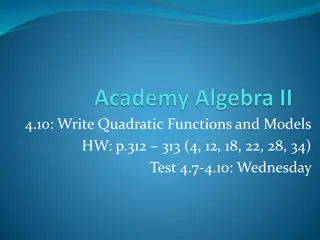Hydrogen Energy Storage Market
Hydrogen is produced through electrolysis of water and the gas is stored in medium or large sized containers according to the requirements. The gas can be converted into energy in combustion engine or in fuel cell. Usually, hydrogen energy is stored in three form; liquid, solid, and gaseous form. To
2 views • 6 slides
Software Analysis and Design Process
Software analysis and design involve a systematic approach to understanding user requirements, creating logical models, and transitioning to detailed design specifications. Requirements analysis focuses on capturing system requirements, while design translates these requirements into implementation
8 views • 16 slides
Sheffield Early Help Assessment Form Update and Integration with Extended Support Plan
Sheffield has introduced an updated Early Help Assessment form to streamline the assessment process within the Early Help System. This new form combines the Early Help Assessment with the Extended Support Plan, aligning various assessment tools and referral forms into one comprehensive document. The
6 views • 22 slides
Enhancing Accessibility Through Effective PDF Form Design
Learn how to create accessible PDF forms by choosing the right approach, designing form fields effectively, and utilizing the Prepare Form tool. Understand the considerations involved in tagging and adding form fields, and ensure the correct layout for improved accessibility.
3 views • 31 slides
Comprehensive Guide to Using the New Faculty Data Form
Explore the detailed instructions, functionalities, and features of the updated Faculty Data Form (FDF) introduced in November 2020 by the Office of the Provost. This guide covers essential aspects like primary functions, form content overview, new form features, available functionalities, and more.
3 views • 27 slides
Form I-9 Training in Human Resources: Requirements and Process Overview
Form I-9 Training provides essential information on verifying the Form I-9 for new employees in compliance with the Immigration Reform and Control Act of 1986. This training clarifies the basics, objectives, and purpose of Form I-9, outlining the three sections involved in the completion process. Di
1 views • 28 slides
Guidelines for Design of Cement Concrete Pavement and Interlocking Paver Blocks
This document provides guidelines for designing cement concrete pavements and interlocking paver blocks, covering factors governing design, wheel loads, design period, subgrade characteristics, approximate k values based on CBR values, and the importance of a sub-base below concrete pavements. It em
0 views • 67 slides
Federal Fiduciary Income Tax Returns Overview
Form 1041 is an income tax return for trusts or estates reporting income earned by the assets. Understand filing requirements, types of returns, and deadlines for Form 1041, Form 706, and Form 1040. Learn about calendar year vs. fiscal year options for estates and trusts.
0 views • 15 slides
Software Engineering Design Principles and Concepts
The chapter discusses the essential principles and concepts in software design, highlighting the four key design models - data design, architectural design, interface design, and component-level design. It emphasizes the importance of traceability to the analysis model, minimizing the gap between so
2 views • 36 slides
Essential Concepts in Dosage Form Design
Understanding the formulation and design of dosage forms is crucial in pharmaceutical sciences. Drug substances are combined with nonmedicinal agents to create stable, effective, and safe products. Considerations such as compatibility, quality control, labeling, and storage play key roles in dosage
4 views • 35 slides
Guidelines for Completing Student Evaluation Form
Instructions on filling out a student evaluation form including entering student names, semester details, clinic/preceptor information, and providing appropriate feedback in the form of comments. The evaluation form does not require final grade calculation and should be reviewed with the student bef
0 views • 9 slides
Guide to Completing Your Progress Report Form
Accessing the progress report form, key steps in filling it out, and troubleshooting tips. Includes where to find the form, how to list track courses, select courses, enter graduation date, and submit the form. Helpful images provided for reference. For any issues encountered, follow the suggestions
0 views • 8 slides
How to Fill Out a Nursing Assistant Certification Reimbursement Request Form
Detailed instructions on filling out Form 06-123 for Nursing Assistant Certification (NAC) reimbursement requests. Sections covered include Provider Information, Direct Care Costs, Operating Costs, Total Costs, and Provider Authorization. The form requires manual entry of some totals and provides au
0 views • 16 slides
Completing the Square Method: Vertex Form and Solving Equations
The Completing the Square method helps convert quadratic equations from standard form to vertex form, facilitating the quick determination of the vertex point and the solutions without factoring. By completing the square, you transform equations like y = x^2 + bx + c into y = (x − h)^2 + k, enabli
0 views • 5 slides
UserForm in Visual Basic for Applications (VBA)
UserForm in VBA allows customization of user interfaces using standard Windows controls, providing a form similar to a standard Windows form. This tool lets you design forms on a blank canvas by selecting and placing controls from the Toolbox window. Properties of the form, its events, and methods c
0 views • 37 slides
Quadratic Functions and Models: Characteristics and Equations
Explore writing quadratic functions given specific characteristics such as vertices, x-intercepts, and points passed through. Learn how to form equations in vertex form, intercept form, and standard form by plugging in values and solving systems of equations. Practice creating quadratic functions wi
0 views • 8 slides
System on Chip (SoC) Design and Components
Explore the world of System on Chip (SoC) design, components, and working flow. Learn about Intellectual Properties (IP), platform-based design, typical design flows, top-down design approach, and the emerging Electronic System Level (ESL) design flow. Discover the essential components of an SoC, su
0 views • 45 slides
Design Inspiration and Elements in Costume and Fashion Design
Dive into the world of costume and fashion design through a visual journey of finding design inspiration, understanding the design process, emphasizing originality, and exploring different sources of creativity. Discover how technology, art, food, history, architecture, and nature can spark innovati
0 views • 45 slides
Enhancing Piping Design Efficiency with Spec-Driven Technology
Explore how Spec-Driven Piping technology powered by CADACTIVE offers a standardized approach for piping design in Creo Parametric. This innovative extension streamlines design communication, eliminates errors, and improves design efficiency by utilizing a master catalog, automated checking capabili
0 views • 15 slides
Framework and Refinement in Human Computer Interface Design
This content delves into the requirements definition process for designing products with a focus on interaction design. It covers creating personas, identifying design requirements, and utilizing scenarios to extract needs and define fundamental interaction frameworks. The process involves defining
0 views • 30 slides
Material Design: Combining Classic Design Principles with Technological Innovation
Material Design is a design language that combines traditional design principles with the possibilities offered by technology and science. It emphasizes visual language, classic design elements, and innovation to create delightful user experiences. The Material Metaphor, Imagery, Typography, Color,
0 views • 34 slides
Guide to Using Electronic Forms System (EFS) for Form LM-1
This guide provides instructions on using the Electronic Forms System (EFS) for completing and filing Form LM-1, the Labor Organization Information Report. It covers system requirements, accessing the system, registering for a PIN, and accessing the form within EFS. For detailed instructions on repo
0 views • 36 slides
Simplify Data Entry with Forms in MIS - Chapter 3 Overview
Explore the world of forms in Management Information Systems (MIS) to streamline data entry processes. Learn about designing and utilizing forms effectively, including different form types, form views, controls, and the form wizard. Discover how form views, layout views, and design views contribute
0 views • 25 slides
Comprehensive Guide to System Design Components and Techniques
System design involves the detailed planning and identification of components in an information system, aiming to provide users with a general understanding of the new system. This process includes techniques like flowcharts, prototyping, and component design, covering aspects such as output design,
0 views • 24 slides
Design Patterns: A Comprehensive Overview
Exploring the world of design patterns, this content delves into the essence of design patterns, their application in software design to resolve complexity, and the different types of design patterns - creational, structural, and behavioral. It also showcases examples of popular design patterns such
0 views • 22 slides
Basic Concepts in Software Design
Software design involves transforming customer requirements into a form suitable for implementation, with activities categorized into preliminary and detailed design stages. High-level design focuses on module identification and control relationships, while detailed design entails defining data stru
1 views • 24 slides
Graduate Non-Resident Tuition Exception Form Overview
Explore the Graduate Non-Resident Tuition Exception Form, an online tool for submitting requests for non-resident tuition waivers. This comprehensive guide covers the form's structure, pre-populated sections, requester and student information input, funding request details, and the submission proces
0 views • 23 slides
3D Design and Critical Analysis in Architecture
Dive into the world of 3D design and critical analysis with a focus on architecture. Discover the stages of design, essential skills for designers, and areas of study in three-dimensional design. Delve into iconic buildings like Frank Lloyd Wright's Falling Water, analyze their key features, and eve
0 views • 9 slides
Design Patterns in Object-Oriented Design
Design patterns in object-oriented design (OOD) are essential templates that codify best practices for solving common problems. They help streamline development by capturing proven design decisions, promoting code reuse, and enhancing system flexibility and modularity. Learn about the core concepts,
0 views • 20 slides
Moseley Sixth Form Application Information for September 2021
Providing personal details, course interests, academic background, and preferences for Moseley Sixth Form application in September 2021. Includes sections on learning difficulties, support systems, career ambitions, work experience, hobbies, and reasons for choosing Moseley Sixth Form. Additionally,
0 views • 5 slides
Interaction Design in Human-Computer Interaction
Interaction design focuses on creating interactive products that are easy, effective, and enjoyable to use. It aims to reduce negative user experiences while enhancing positive ones. Designing interactive products requires understanding user activities, interfaces, and device arrangements to support
0 views • 11 slides
Guide to Filing 2015 Federal Tax Return with 1040NR-EZ Form
Learn about filing your 2015 Federal Tax Return using the 1040NR-EZ form, including guidance on completing the form, using tax preparation software, and determining eligibility. Understand the criteria for completing the 1040NR-EZ form and find resources to help you navigate through the tax filing p
0 views • 78 slides
SE2811 Software Component Design Overview
This course covers software component design, design patterns, object-oriented design, algorithms, and opportunities for reuse in systems design. It emphasizes the importance of domain-level design and provides insights into solving core problems through reusable classes.
1 views • 21 slides
Analysis of Bunch Lengthening in CEPC for Different Design Parameters
This study explores bunch lengthening in the Circular Electron Positron Collider (CEPC) for various design parameters, analyzing a 54 km design scheme, a 61 km design scheme, and a 100 km design scheme. The analysis includes the theoretical framework used, equations for bunch lengthening, and conclu
1 views • 15 slides
Plain & Reinforced Concrete Structures in Design Engineering
In the design of Plain & Reinforced Concrete structures, various strength design methods such as Ultimate Strength Design (USD) and Allowable Strength Design (ASD) are utilized. These methods involve factors of safety, material strength, load factors, and analysis in the elastic range. Additionally,
0 views • 11 slides
Verilog Adder Examples & Typical IC Design Flow
This comprehensive content delves into Verilog adder examples, typical IC design flow, physical design considerations, and examples of OpenGL ES GPU and ARM hypervisor applications. It covers the fundamentals of digital logic with Verilog design, hardware description language, FPGA prototyping, phys
1 views • 27 slides
DA Form 5988-E for Equipment Maintenance
The DA Form 5988-E is divided into three sections: Equipment Data, Parts Requested, and Maintenance Faults. It is essential for identifying a vehicle's status, tracking parts orders, and recording faults. Regular updates and proper documentation are crucial to ensure the form reflects the current co
0 views • 16 slides
The Importance of Software Design for Data Scientists
Today's ISEA Session 2 with David Beck from the University of Washington delves into the critical role of intentional software design for data scientists. The session covers the software design approach, user-centric design stories, use cases, components, testing strategies, and the benefits and dra
1 views • 76 slides
Engine Classification and Design
Engine classification involves categorizing engines based on various factors such as combustion type, number of strokes, cylinder design, and ignition method. Common classifications include external and internal combustion engines, as well as categories based on the design and use of the engine. Add
0 views • 11 slides
PA Dutch 101 - Command Forms
PA Dutch 101 Video 37 covers Command Forms in Pennsylvania Dutch. There are three command forms: Singular, Plural, and Lets. The choice of form depends on the number of people being addressed. The Singular Form is used for one person, the Plural Form for multiple people, and the Lets Form when sugge
0 views • 8 slides







































